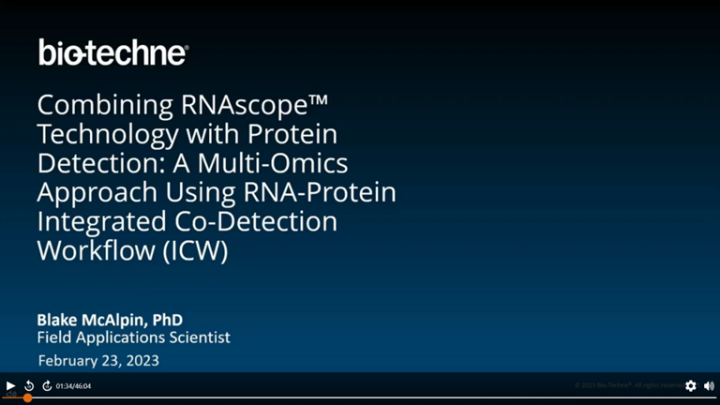Incorporation and Automation of RNAscope Technology Into Your COVID-19 Viral Pathogenesis Research



Direct detection of viral RNA in human or other animal cells by RNA in situ hybridization ( ISH) technology is a powerful tool to establish the etiology and pathogenesis of viral disease. Nucleic acid-based molecular detection methods have revolutionized viral detection, offering several essential advantages such as sensitivity, specificity, and speed. Beyond this, RNAscope ISH technology uniquely offers a molecular detection at a single cell resolution coupled with morphological context to enable visualization of the virus in different infected tissues and cell types. In this webinar, we will demonstrate how RNAscope technology can be used to detect viral infection and pathogenesis for research, and enhance our understanding of globally important viruses, such as SARS-CoV-2. For research labs that require high throughput and automated RNA in situ hybridization (ISH) technology on BOND RX, Bio-Techne has partnered with Leica Biosystems to deliver RNAscope® ISH automated assays.* Here we present the Bio-Techne products and technical suggestions to successfully execute RNAScope technology on BOND RX stainer from Leica Biosystems.
*Performance claims of the probes for those assays have not been established
Learning Objectives
- RNAScope Technology Overview - Learn how the RNAScope technology works and why it is great on the Leica BOND RX Research Platform
- See the proof - publications that show how COVID-19 Detection and Probes deliver the results researchers seek
- Learn about the COVID-19 Offerings (Bio-Techne) on the BOND RX stainer from Leica Biosystems
Webinar Transcription
- Incorporation and Automation of RNAscope Technology into your COVID-19 Viral Pathogenesis Research. Research Use Only, Not for Clinical Diagnostic Procedure
- For Research Use Only. Not For Diagnostic Use. Incorporation of the highly sensitive and specific RNAscope technology into your COVID-19 Viral Pathogenesis Research Jyoti Sheldon Applications Research Use Only, Not for Clinical Diagnostic Procedure
- Agenda RNAscope technology overview COVID-19 Offerings COVID-19 Publications Research Use Only, Not for Clinical Diagnostic Procedure
- RNAscope®In Situ Hybridization (ISH) Technology A hybridization-based signal amplification system with a unique probe design - Simultaneous signal amplification and background suppression Amplification Target-specific binding A specific and sensitive method to detect RNA biomarkers in cells and tissues with morphological context Signal AmplificationTarget Probe Detection and Quantification • Single RNA molecule detection technology • Simultaneous detection of multiple RNA markers • Fluorescent or chromogenic labeling • Spatial mapping of mRNA, lncRNA, splice variants, highly homologous sequences, and point mutations in cells and intact tissues • FFPE tissues, fresh frozen or fixed frozen tissues, PBMCs, cultured cells,… Research Use Only, Not for Clinical Diagnostic Procedure
- Probe design & signal amplification yields high signal:noise ratio Target sequence ZZ Z Pre-amplifier binding site Target binding site Linker ZZ Pre-amplifier ZZ Amplifier Labeled probe (Chromogenic enzyme or Fluorophore) ZZ Z Sensitivity Specificity Research Use Only, Not for Clinical Diagnostic Procedure
- PROBES: * Currently >22,000 probes in catalog * Probes can be designed against any target from any species in 2 weeks RNAscope Assays 2.5 HD BROWN 2.5 HD RED 2.5 HD Duplex Multiplex Fluorescent Multiplex Fluorescent (V2) HiPlex BaseScope BaseScope Duplex Assay type Chromogenic Chromogenic Chromogenic Fluorescent Fluorescent Fluorescent Chromogenic Chromogenic Dye used HRP- DAB ALP-Fast Red HRP-Green ALP-Fast Red Alexa Fluor 488 Atto 550 Atto 647 HRP-Opal (Akoya Biosciences) Alexa Fluor 488 Atto 550 Atto 647N Alexa Fluor 750 ALP-Fast Red HRP-Green ALP-Fast Red Plexing offered 1 target 1 target 2 targets Up to 3 targets Up to 4 targets Up to 12 targets 1 target 2 targets Automation capabilities Leica Ventana Leica Ventana Leica Ventana Leica Leica Ventana RNAscope and BaseScope Product Portfolio Research Use Only, Not for Clinical Diagnostic Procedure
- RNAscope and BaseScope Product Portfolio Coming Soon!!! miRNAscope Assay Research Use Only, Not for Clinical Diagnostic Procedure
- RNAscope ISH: Ideal for viral detection • Detection with morphological context provides viral localization • Entry portal, replication site, disease site, shedding, viral dynamicsContext • High sensitivity detects low viremia • Early infection and latent stagesSensitivity • High specificity discerns closely related viruses • Detect any species provided sequence is knownSpecificity • Rapid probe design enables detection of any sequenced virus • Essential for emerging viruses without available antibodiesRapid • Single-stranded and strand-specific probes discern viral stages • Hybridize to sense (+) or anti-sense (-) strand to detect replication, resting stagesStrand-specific Research Use Only, Not for Clinical Diagnostic Procedure
- RNAscope ISH : Detect wide range of viral Species …and more V-nCoV2019-S Coronavirus Research Use Only, Not for Clinical Diagnostic Procedure
- For Research Use Only. Not For Diagnostic Use. COVID-19 Offerings Research Use Only, Not for Clinical Diagnostic Procedure
- Product Offerings for COVID-19 Virus Detection MORPHOLOGICAL CONTEXT, WITH SPECIFICITY AND SINGLE MOLECULE SENSITIVITY DETECT VIRUS using RNAscope 2.5 LS Reagent Kit – Brown/Red RNAscope Probe (s) for COVID- 19 DETECT VIRUS –RECEPTOR INTERACTION using RNAscope 2.5 LS Duplex Reagent Kit or RNAscope LS Multiplex Reagent Kit and RNAscope Probe (s) COVID-19, ACE2,TMPRF DETECT VIRUS-RECEPTOR- IMMUNE RESPONSE using RNAscope LS Multiplex Reagent Kit and RNAscope Probe (s) for COVID-19, Cytokines DETECT VIRUS-PATHOLOGICAL TISSUE MARKERS –IMMUNE RESPONSE using RNAscope LS Multiplex Reagent Kit and RNAscope Probe (s) for COVID- 19 ,all Cytokines, AQP5,SFTBP, RAGE MORPHOLOGICAL CONTEXT, WITH SPECIFICITY AND SINGLE MOLECULE SENSITIVITY Research Use Only, Not for Clinical Diagnostic Procedure
- Coronavirus Probe Information o A RNAscope Probe (V-nCoV2019-S, Catalog number 848561) is available targeting the Coronavirus outbreak in Wuhan, China from 2019. o This probe was designed to specifically detect the Spike (S) protein of this Novel Coronavirus. o This V-nCOV2019-S probe was designed to avoid cross detections to SARS (2003), MERS and other Coronavirus, Ebola Virus or HIV. o This probe can be used in a variety of animal models including human, mouse, rat, monkey, potential natural hosts ferret, bat etc. o This probe can be used to study localization / infiltration of the virus in the tissue. Research Use Only, Not for Clinical Diagnostic Procedure
- Markers for studying the pathophysiology of COVID-19 Function Markers Viral detection SARS-CoV-2, SARS-CoV-2 sense Host cell markers ACE2, TMPRSS2, CATHEPSIN B & L Inflammatory response IL1 alpha, IL1B ,IL2, IL6, IL7 ,IL10 I,IL12 ,TNFALPHA, IP10 ,MIP1ALPHA Histopathological markers AQP5,SFTBP, RAGE, SP-D, KL-6, CC16 Research Use Only, Not for Clinical Diagnostic Procedure
- ISH-IHC for COVID-19 research ISH-IHC workflow can be used to identify cell types within infected tissues using immunohistochemistry or immunofluorescence, and visualize viral RNA, host cell protease , host and viral gene expression using RNAscope in situ hybridization. Examples of potential combinations: • SARS-CoV-2(ISH) + ACE2(IF) • SARS-CoV-2(ISH) + TMPRSS2(ISH) + ACE2(IF) Research Use Only, Not for Clinical Diagnostic Procedure
- Chandrashekar et al, Science, 2020 SARS-CoV-2 infection protects against rechallenge in rhesus macaques • Chandrashekar et al., developed a rhesus macaques model for SARS-CoV-2 infection to study the pathological and immunological features of COVID-19. • They also used this model to study the natural immunity against SARS-Cov-2 after re-exposure. • Inoculation with virus induced SARS0CoV-2- specific antibodies in the animals. • Viral RNA was visualized in the lung tissue including the bronchial respiratory epithelium using the RNAscope 2.5 HD Red assay SARS-CoV-2 viral inoculation generated a humoral immune response in the animals High viral load Moderate viral load Low viral load SARS-CoV-2-S RNA detected in the lungs using RNAscope Genomic RNA replicate LungtissueBronchialepithelial cells SARS-CoV-2 RNA Visualization of viral replication in the respiratory tract of the Rhesus macaques SARS-CoV-2 model Intermediate Research Use Only, Not for Clinical Diagnostic Procedure
- Visualization of viral replication in the respiratory tract of the Rhesus macaques SARS-CoV-2 model • Co-localization of cytokeratin with viral nucleocapsid protein (Novus Biologicals) indicated infection in alveolar epithelial cells. • Re-challenging the animals with SARS-CoV-2 post initial exposure led to minimal viral RNA detection post re-exposure indicating they had developed natural immunity against the virus. SARS-CoV-2 infects alveolar epithelial cells in rhesus macaques Animals exhibited anamnestic immune response upon SARS- CoV-2 rechallenge Chandrashekar et al, Science, 2020 SARS-CoV-2 infection protects against rechallenge in rhesus macaques Key message: RNAscope enabled visualization of viral replication in the respiratory tract of the rhesus macaques SARS-CoV-2 model which can be used for testing vaccines and therapeutics. Research Use Only, Not for Clinical Diagnostic Procedure
- Host Receptor detection in studying viral mode of acquisition Hou et al., Cell, 2020 SARS-CoV-2 Reverse Genetics Reveals a Variable Infection Gradient in the Respiratory Tract RNAscope ISH detects ACE2 in Cytospin samples RNAscope ISH detects ACE2 and TMPRSS2 in normal human airway surface epithelium • Hou et al, used a reverse genetics system to study SARS-CoV-2 growth and pathogenesis. • Using the RNAscope/Cytospin technology they detected ACE2 expression in upper respiratory tract with increased sensitivity and efficacy compared to scRNA- seq. KEY MESSAGE Using the RNAscope assay the researchers established an ACE2 expression gradient and TMPRSS2 detection in the respiratory tract along with the SARS-CoV-2 virus Research Use Only, Not for Clinical Diagnostic Procedure
- RNAscope ISH assay used to visualize ACE2 and TMPRSS2 in normal vs Cystic Fibrosis Lung Host Receptor detection in studying viral mode of acquisition Research Use Only, Not for Clinical Diagnostic Procedure
- RNAscope successfully detected SARS-CoV-2 viral RNA in infected NHP FFPE cell pellets Liu et al., JCI Insight, 2020 Molecular Detection of SARS-CoV-2 in Formalin Fixed Paraffin Embedded Specimens • Severe acute respiratory syndrome coronavirus 2 (SARS-CoV-2) , the etiologic agent of COVID-19 infects cells by engaging its Spike (S) protein with the host cell receptor, ACE-2, in turn facilitating viral entry. • Sensitive and specific techniques for viral detection are necessary for understanding the pathogenesis of SARS-CoV-2. • Liu et al. assessed multiple IHC antibodies and the RNAscope ISH assay for viral detection in infected African green monkey kidney cells. • Using the RNAscope 2.5 HD Red chromogenic assay they detected the SARS- CoV-2 spike protein RNA (positive) and the replicate intermediate RNA (negative) in the FFPE cell pellets. • The RNAscope Multiplex Fluorescent v2 assay was used to simultaneously visualize the positive and negative Spike protein mRNA in the same pellet. • Interestingly, the SARS-CoV-2 positive RNA demonstrated more cytoplasmic expression while the SARS-CoV-2 replicate intermediate RNA was localized to the perinuclear inclusion bodies. SARS-CoV-2 viral RNA and replicate intermediate detected using RNAscope 2.5 HD Red assay Simultaneous detection of SARS-CoV-2 viral RNA and replicate intermediate using RNAscope Multiplex Fluorescent assay Research Use Only, Not for Clinical Diagnostic Procedure
- Co-detection of SARS-CoV-2 S viral RNA and protein demonstrated concordance between RNAscope- ISH and IHC techniques • Using Dual ISH -IHC researchers visualized SARS-Cov-2 spike protein mRNA and protein on the same FFPE pellet. Probe name Catalog no. Comments RNAscope® Probe - V-nCoV2019-S 848561 854841 and 854851 cross detect with SARS- CoV-1 and were designed very early on (not recommended). RNAscope® Probe - V-nCoV2019-S-sense 845701 RNAscope® Probe - V-SARS-CoV-2-S 854841 RNAscope® Probe - V-SARS-CoV-2-S-sense 854851 Probes Used: RNAscope successfully detected SARS-CoV-2 viral RNA in infected NHP FFPE cell pellets Key message: Using SARS-CoV-2 positive and negative strand specific RNAscope probes researchers were able to detect the virus and visualize viral replication. Liu et al., JCI Insight, 2020 Molecular Detection of SARS-CoV-2 in Formalin Fixed Paraffin Embedded Specimens Research Use Only, Not for Clinical Diagnostic Procedure
- Organotropism influences COVID-19 disease progression • In a study of 27 autopsy patients, SARS-CoV-2 virus could be detected in multiple organs including lungs, pharynx, heart, liver , brain and kidneys. • Researchers found a strong association between more than two coexisting conditions in patients and SARS-CoV-2 tropism in the kidneys. • They detected the SARS-CoV-2-S viral RNA with spatial resolution in PCR positive FFPE lung and renal parenchyma samples using the RNAscope assay. • These data revealed that SARS-CoV-2 has an organotropism and can affect other organs in addition to the lungs potentially aggravating preexisting conditions. Puelles et al, NEJM, 2020 Multiorgan and Renal Tropism of SARS-CoV-2, The New England Journal of Medicine, 2020 SARS-CoV-2-S RNA was visualized in the lung and kidney samples using the RNAscope ISH assay Research Use Only, Not for Clinical Diagnostic Procedure
- In utero vertical transmission of SARS-CoV-2 validated using RNAscope • There has been conflicting data about the possibility of vertical transmission of SARS-CoV-2 from mother to baby in the womb. • In this study researchers studied 2 cases that were SARS-CoV-2 ‘PCR positive’ for mother, neonate and placenta. • Using the RNAscope 2.5 LS Brown assay they could visualize the virus in the placental tissue and evaluate the tissue distribution while retaining the morphological context. • RNAscope validated the presence of SARS-CoV-2 RNA in the infected placentas supporting the possibility of vertical transmission of SARS-CoV-2 from mother to baby in utero. SARS-CoV-2-S RNA in the syncytiotrophoblasts of COVID-19 positive mothers Absence of SARS-CoV-2-S RNA in the syncytiotrophoblasts of COVID-19 positive mother Neonates were also COVID-19 positive Neonate was COVID-19 negative Patane et al., Jour of Ob and Gynec, 2020 Vertical transmission of COVID-19: SARS-CoV-2 RNA on the fetal side of the placenta in pregnancies with COVID-19 positive mothers and neonates at birth Research Use Only, Not for Clinical Diagnostic Procedure
- Role of COVID-19 in pregnancy outcomes • The effects of COVID-19 in pregnant women are relatively unknown. This study presents a case of a COVID-19 positive patient in second trimester, complicated by sever pre-eclampsia and placental abruption. • It is important to distinguish between the physiological effects of pre-eclampsia and COVID-19 for better prognosis of pregnancy. • RNAscope 2.5 HD Brown assay was used to visualize the SARS-CoV-2 RNA in the placental tissue. • The SARS-CoV-2-S RNA staining pattern closely matched that of the ACE2 receptor as seen on the Human Protein Atlas (HPA). Hosier et al, Pre-print, 2020 SARS-CoV-2 Infection of the Placenta RNAscope ISH analysis detected the SARS-CoV-2-S RNA in the human placental tissue of COVID-19 positive patient in second trimester SARS-CoV-2-S Positive staining indicates SARS-CoV-2 infection Research Use Only, Not for Clinical Diagnostic Procedure
- Detection of the SARS-CoV-2 virus in NHP lung tissues using RNAscope-ISH • Lu et al., developed a model to study the SARS-CoV-2 pathogenesis to aid in the advancement of viral vaccine and drug development. • Using RNAscope Multiplex Fluorescent v2 assay they observed differences in susceptibility to SARS-CoV-2 between the 3 NHP species with the M.mulatta species being more susceptible compared to M. fascicularis and C.jacchus. Lu et al., pre-print, 2020 Comparison of SARS-CoV-2 infections among 3 species of non-human primates Visualization of SARS-CoV-2 Spike protein RNA in infected non-human primate tissues indicates punctate positive staining for SARS-CoV-2 using the RNAscope® Probe- V-nCoV2019-S Key message: RNAscope can detect different degrees of viral distribution in different tissues demonstrating high sensitivity and specificity for SARS-CoV-2 detection. Research Use Only, Not for Clinical Diagnostic Procedure
- RNAscope Adoption: 2700+ Peer-Reviewed Publications 4 15 62 157 366 671 1,136 1,880 2,659 2,752 0 500 1000 1500 2000 2500 3000 2011 2012 2013 2014 2015 2016 2017 2018 2019 2020 0 200 400 600 800 1000 Other Immunotherapy non-coding RNA Inflammation Developmental HPV Stem Cells Infectious Neuroscience Cancer # of Publications ResearchAreas Publications by Research Area 2011-2020 Research Use Only, Not for Clinical Diagnostic Procedure
- Summary SPECIFICITY The RNAscope technology uses a unique probe design strategy to dramatically improve signal-to-noise ratio Currently have >22,000 probes on catalog (new probes can be designed and made within 2 weeks for any target and any species) SENSITIVITY The RNAscope technology uses a patented amplification system and fully optimized assay conditions 12 MULTIPLEXING The newest assay, RNAscope HiPlex, can detect up to 12 targets simultaneously in the tissue at single-cell resolution 1-3 ZZ SPLICE VARIANTS AND SHORT TARGETS The BaseScope assay can detect splicing variants and short sequences down to ~50 nucleotides ISH/IHC The RNAscope and BaseScope assays can be complemented by IHC/IF for simultaneous RNA and protein detection on the same slide Research Use Only, Not for Clinical Diagnostic Procedure
- • Contact us: • Jyoti Phatak Sheldon: jyoti.phatak@bio-techne.com • ACD Support: support.acd@bio-techne.com Visit us: www.acdbio.com
About the presenters

Jyoti Phatak-Sheldon holds a Master’s degree in Molecular and Cell Biology along with a Bachelor's in Dental Surgery. She has previously worked in the field of genomics and precision diagnostics as a product specialist for qPCR-based liquid biopsy tests. Jyoti currently works at Advanced Cell Diagnostics as an associate scientist in the applications team to execute projects and collaborations that demonstrate novel applications of RNAscope and BaseScope™ assays.

Andrea De Biase has been a Field Application Scientist at Advanced Cell Diagnostics since 2017, based in Los Angeles, CA covering the southwest territory. Prior to joining our company, he has been an FAS covering Real time and Digital PCR applications at Thermo Fisher Scientific and Raindance. Before working for the biotech industry, he spent over 10 years in the academic environment where he worked on a variety of scientific projects that involved solving and troubleshooting a wide variety of technical issues. Andrea has a Master’s degree in Biology from the University of Milan in Italy.

Damian is the Global Product Manager for the clinical and research BOND systems and is based in Melbourne, Australia. Damian joined Leica Biosystems as a Scientist in 2007 working on the development of BOND-III. Throughout his career at Leica Biosystems he has held numerous roles working across the broad portfolio of Leica Biosystems products, included spending 7 years based out of the Newcastle UK site before returning to Australia in 2018.
Related Content
Leica Biosystems content is subject to the Leica Biosystems website terms of use, available at: Legal Notice. The content, including webinars, training presentations and related materials is intended to provide general information regarding particular subjects of interest to health care professionals and is not intended to be, and should not be construed as, medical, regulatory or legal advice. The views and opinions expressed in any third-party content reflect the personal views and opinions of the speaker(s)/author(s) and do not necessarily represent or reflect the views or opinions of Leica Biosystems, its employees or agents. Any links contained in the content which provides access to third party resources or content is provided for convenience only.
For the use of any product, the applicable product documentation, including information guides, inserts and operation manuals should be consulted.
Copyright © 2024 Leica Biosystems division of Leica Microsystems, Inc. and its Leica Biosystems affiliates. All rights reserved. LEICA and the Leica Logo are registered trademarks of Leica Microsystems IR GmbH.


